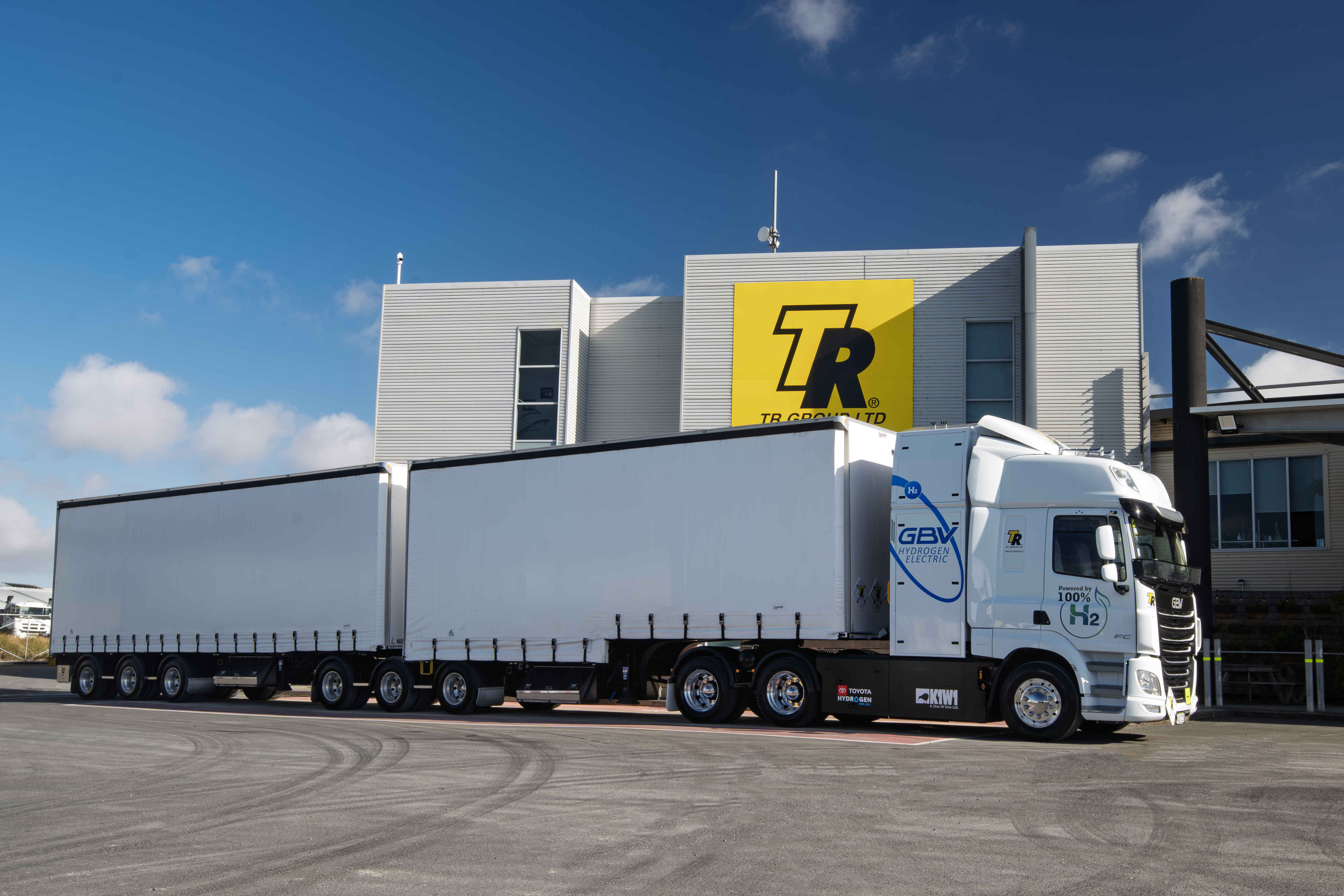
The "hydrogenation" (not the right word) of transport continues in New Zealand. This time it's Toyota New Zealand which has joined with TR Group and Global Bus Ventures (GBV) in Rolleston, to launch a hydrogen powered 50-tonne prime mover that hauls trailers.
GBV's no-emission hydrogen lorry is built on DAF CF 530 that is fitted with two Toyota 85 kilowatt (kW) fuel cells, so 170 kW in total. Onboard hydrogen storage is 52 kg and there's also a 124 kWh battery.
An electric motor mated to a six-speed gearbox supplies 350 kW of power, with a hefty 2400 Newton metres of torque for moving heavy loads.
This adds up to a tested 450 to 500 kilometre range, the three companies said. What's more, refuelling times are comparable to diesel fill-ups at 15 minutes. As you can tell, the truck looks like a regular lorry minus the icky diesel fumes.
TR Group, which rents out trucks and trailers, will operate the 50-tonne lorry, and will add another 16 to its fleet, along with four Hyundai Xcient fuel cell electric vehicles (FCEVs); the company's general manager Brendan King said several H W Richardson fuel-cell CH2NGE dual-fuel trucks will be added to the mix as well.
The trucks are supported by a government programme, and Hiringa Energy that began when the Labour-led coalition was in power.
Hiringa Energy's chief executive Andrew Clennett reckons hydrogen is "more viable than ever" now, and that having a New Zealand-based truck integrator makes it even more so.
Some 95% of North Island freight routes are covered by the Hiringa refuelling network; that's green hydrogen as well, which HE says is zero-emission.
NZ preps hydrogen-electric flights as well
Last month, we covered the Australian efforts to build fuel-cell powered planes, with Deakin University and AMSL Aero developing the Vertiia box-wing plane with 1000 km range, 300 km/h speed and 500 kg payload.
Now, Stralis Aircraft, Fabrum and clean energy hub Ara Ake are collaborating to get hydrogen-powered aviation off the ground in New Zealand as well.
Stralis is an Australian company, and it intends to integrate New Zealand firm Fabrum's tanks and fuel systems into its aircraft. Here's the Stralis Aircraft SA1, which is billed as "the world’s first 50-seat aircraft optimised for hydrogen-electric technology. Designed to fly 3000km it will achieve ~50% lower operating costs than comparable aircraft."

If that range is achievable, the SA1 would seem to be ideal for New Zealand routes.
Ara Ake meanwhile supports the project, and Fabrum has announced a hydrogen testing facility at Christchurch International Airport.
Stralis claims its fuel-cell technology is designed to be lighter than existing alternatives, and potentially enable planes to fly 10 times further than battery electric planes; and, at a lower cost than fossil fuel flights.
The key here is green hydrogen made with renewable energy, which the three organisations say has three times the energy density of sustainable aviation fuel (SAF), and more than 100 times that of batteries.
If the above projects pan out commercially, they should go a long way towards the decarbonisation of land and air transport.
11 Comments
Such welcome and sensible news: energy in a bottle without the need for a massively expensive whole-network capability upgrade to cope.
In the long run I wonder if it will be compressed H2, or another Hydrogen carrier like Ammonia for direct use in a fuel cell #Amogy, or metal hydrides #Lavo or one of the other fast-evolving technologies.
I also wonder if there's any chance we can wind down the Tiwai Point Smelter (13% of our national electricity use) and use the energy to make green Hydrogen and other locally useful and exportable products in Southland, rather than enriching Rio Tinto in Melbourne (who own about 80% of the smelter).
Raising the power prices in the next contract might be a simple way to encourage them to move on - although those contracts, negotiated in 2024, are for 20 years. Even though it includes demand management clauses to cope with our generation's shortfalls in the ability to cope with peak demand, do you get the feeling the negotiators on one side of that table were a bit smarter than those on the other?
On looking up Ara Ake - previously the (government funded) National New Energy Development Centre.
Bollocks.
The energy has to come from somewhere. You cannot conjure it up out of thin air. The EROEI of hydrogen-from-electricity is awful - no modern society can run on such a loss-making energy degradation. Better to use the electricity directly - and believe me, ex fossil fuels, we'll be doing just that. Food first, aircraft last.
Whatever the 'colour', hydrogen is a complexity we cannot support. And won't. The conundrum is that we will end up on 'renewables' by default - but they are better described as 'rebuildables'; dams, PV, windmills. None have ever replicated themselves, while also producing surplus energy - which should ring alarm bells.
As should the not-so-subtle 'The key here is green hydrogen made with renewable energy, which the three organisations say has three times the energy density of sustainable aviation fuel (SAF), and more than 100 times that of batteries.' The writer of this article could perhaps do some homework on that.... It's spin and bull--it, and I would hope someone can see through that?
After such a strong logical start to your argument; any references to underpin your assertions?
https://sciencenotes.org/what-is-entropy-definition-and-examples/#:~:te…
https://science.howstuffworks.com/entropy.htm
https://www.reddit.com/r/energy/comments/nh2b4g/free_textbook_energy_an…
https://dothemath.ucsd.edu/2011/10/the-energy-trap/
https://www.thegreatsimplification.com/episode/63-paul-martin
come back if you want more :)
EDIT - that is the homework I'd have expected Juha to have done, given his claim to 'tech' knowledge. Otherwise, what is journalism?
Yes, we get it: the laws of thermodynamics apply and entropy wins.
Human existence is short, is a permanent series finger-in-the-dyke expedients, work rounds, stuff that doesn't make sense at the moment, and experiments with knowledge that is limited and imperfect, but expanding. Our chaotic nature has got us here and it makes the human future hell to predict. From humanity's previous performance something useful is likely to emerge from the ramshackle development in the reasonably close to the here and now, rather than waiting around for the heat death of the universe.
We don't live long, and if you spend your life looking at the horizon, you're going to miss the chance to affect what goes on right in front of you. So, while you're probably right, I don't think it matters to anything on the human scale.
I've seen comments like that before.
Many, many times
You ran... and then turned the narrative.
Try doing the homework?
Data without narrative is just a pile of uncoordinated facts.
And Ad hominem with attempts at condescension and deflection. Interesting.
The economics of producing Hydrogen or SAF with electricity or biomass (SAF) is terrible. It is feasible but costs a fortune. Thats why Meridian and Woodside quietly dropped the hydrogen project in Southland and SAF - Ill believe it when I see it. You need free inputs on both sides and last I looked no one produces stuff for free.
Bit like Biomass for energy - it all assumes free fuel input - what a joke.
Hydrogen for cars and trucks makes about as much sense as slapping steep trade tarriffs on other countries. It will end up costing motorists a fortune and keep us enslaved to the small number of multi-national companies who can afford to set up such an extremely complex and inefficient energy network.
There may be applications for energy with an EROI of less than 1 but only as long as it is considered with the knowledge that every joule devoted to creating (or storing) energy is one that is not available for use.....what are our priorities? and how much of a finite resource can we afford to devote to energy production/storage....and for how long?
Great comment.
Yes, going into space they took fuel cells - but discounted the FF input required to assemble/charge them.
You can do that big (FF) to small (fc) but not in quantity, or in total.

We welcome your comments below. If you are not already registered, please register to comment.
Remember we welcome robust, respectful and insightful debate. We don't welcome abusive or defamatory comments and will de-register those repeatedly making such comments. Our current comment policy is here.